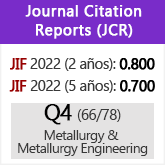Caracterización y evaluación de la templabilidad de una fundición gris empleada en la fabricación de camisas de cilindro para motores diésel
DOI:
https://doi.org/10.3989/revmetalm.101Palabras clave:
Camisas de cilindro, Fundición gris, Motores diésel, Temple convencional, Tratamientos térmicosResumen
El aumento de las propiedades mecánicas (dureza superficial) de las camisas de cilindro es uno de los objetivos de las empresas de fundición especializadas, en miras de aumentar la competitividad de sus productos en el mercado local y extranjero. El objetivo de este estudio se centró en la caracterización de la fundición gris utilizada en la producción de las camisas y en la determinación de los parámetros metalúrgicos en el diseño del tratamiento térmico de temple convencional. Lo anterior, se realizó mediante la evaluación de la templabilidad del material por el método de Grossman y el ensayo Jominy, la selección de la temperatura de austenización y la severidad del medio de enfriamiento para un adecuado endurecimiento del material. Los resultados revelaron que el excelente valor de dureza obtenido luego del tratamiento es atribuido a la adecuada templabilidad de la fundición y a la severidad de temple seleccionada.
Descargas
Citas
Angus, H.T. (1976). Cast Iron: Physical and Engineering Properties. Second Edition, Elsevier Ltd.
ASM Handbook (1991). Heat Treating. Handbook Committee. Vol. 4, ASM International.
ASM Handbook (1992). Castings. Handbook Committee. Vol. 15, ASM International.
ASTM E3-11 (2011). Standard Guide for Preparation of Metallographic Specimens. ASTM International, West Conshohocken, PA.
ASTM A255-10 (2014). Standard Test Methods for Determining Hardenability of Steel. ASTM International, West Conshohocken, PA.
ASTM E7-15 (2015). Standard Terminology Relating to Metallography. ASTM International, West Conshohocken, PA.
ASTM E407-07 (2015). Standard Practice for Microetching Metals and Alloys, ASTM International, West Conshohocken, PA.
ASTM A247-16a (2016). Standard Test Method for Evaluating the Microstructure of Graphite in Iron Castings. ASTM International, West Conshohocken, PA.
Balachandran, G., Vadiraj, A., Kamaraj, M., Kazuya, E. (2011). Mechanical and wear behavior of alloyed gray cast iron in the quenched and tempered and austempered conditions. Mater. Design 32 (7), 4042–4049. https://doi.org/10.1016/j.matdes.2011.03.054
Bates, C.E., Totten, G.H. (1992). Quench Severity Effects on the As-Quenched Hardness of Selected Alloy Steels. Heat Treat. Met. 2, 45–48.
Brooks, C.R. (1979). Heat treatment of ferrous alloys. Editorial McGraw- Hill Book Company, USA.
Clarke, K.D., Van Tyne, C.J. (2005). Effect of Prior Microstructure and Heating Rate on Austenite Formation Kinetics in Three Steels for Induction Hardened Components. Report: Department of Metallurgical and Materials Engineering, Colorado School of Mines, USA. https://www.forging.org/uploaded/content/media/Microstructure_heating.pdf.
Cunningham, J.L., Medlin, D.J., Krauss, G. (1999). Effects of induction hardening and prior cold work on a microalloyed medium carbon steel. J. Mater. Eng. Perform. 8 (4), 401–408. https://doi.org/10.1361/105994999770346684
Davis, J.R. (1996). Cast Irons ASM Specialty Handbook. ASM International, Handbook Committee.
Dimitry, V.B., Carvalho, M.M.O., de Castro, J.A., Lourenco, T.R.M. (2016). Kinetic Study on Martensite Formation in Steels 1045 and 4340 under Variable Cooling Rates. Mat. Sci. Forum 869, 550–555. https://doi.org/10.4028/www.scientific.net/MSF.869.550
DPN (2007). Metalmecánica y Siderurgia. Agenda interna para la productividad y competitividad, Departamento Nacional de Planeación, Documento sectorial. https://es.scribd.com/document/214292177/Metalmecanica-y-Siderurgia.
Ferreira, J.C. (2002). A study of cast chilled iron processing technology and wear evaluation of hardened gray iron for automotive application. J. Mater. Process. Tech. 121 (1), 94–101. https://doi.org/10.1016/S0924-0136(01)01208-0
Gliner, R.E., Vybornov, V.V. (2014). Use of the Standard End Quenching Test for Predicting Heat-Hardening of Cast Iron. Metal Sci. Heat Treat. 56 (7), 424–427. https://doi.org/10.1007/s11041-014-9775-0
Grossman, M.A. (1942). Hardenability Calculated from Chemical Composition. AIME Transactions 150, 227–259.
Lamont, J.L. (1943). How to estimate hardening depth in bars. Iron Age 152, 64–70.
Lasheras, J.M. (1978). Tecnología del acero. Editorial Cedel, Barcelona, Espa-a.
Malinochka, Y.N. (1963). Austenizing gray cast iron. Met. Sci. Heat Treat. 5 (11), 640-646. https://doi.org/10.1007/BF00660555
Maroni, P.J. (1976). Templabilidad: Un método para seleccionar aceros. Editorial librería Mitre, Buenos Aires, Argentina.
Michalski, J., Wo?, P. (2011). The effect of cylinder liner surface topography on abrasive wear of piston-cylinder assembly in combustion engine. Wear 271 (3–4), 582–589. https://doi.org/10.1016/j.wear.2010.05.006
Piyapong, M. (2007). Solidification modeling of iron castings using solid cast. ProQuest, West Virginia University, USA.
Rejowski, E.D., Soares, E., Roth, I., Rudolph, S. (2012). Cylinder Liner in Ductile Cast Iron for High Loaded Combustion Diesel Engines. J. Eng. Gas Turb. Power. 134 (7), 2807–2815. https://doi.org/10.1115/1.4006071
Ruiz, J., López, V., Fernández, B.J. (1996). Effect of surface laser treatment on the microstructure and wear behavior of grey iron. Mater. Design 17 (5–6), 267–273. https://doi.org/10.1016/S0261-3069(97)00020-4
Smolijan, B., Tomasic, N., llikic, D., Felde, I., Reti, T. (2006). Application of Jominy test in 3D simulation of quenching. J. Achiev. Mater. Manuf. Eng. 17 (1–2), 281–284. http://citeseerx.ist.psu.edu/viewdoc/download?doi=10.1.1.548.9283&rep=rep1&type=pdf.
Telejko, I., Adrian, H., Skalny, K., Pakiet, M., Sta?ko, R. (2009). The investigation of hardenability of low alloy structural cast steel. J. Achiev. Mater. Manuf. Eng. 37 (2), 480–485. http://jamme.acmsse.h2.pl/papers_vol37_2/37236.pdf.
Totten, G.E., Bates, C.E., Clinton, N.A. (1993). Handbook of Quenchants and Quenching Technology. ASM International, Materials Park, Ohio, USA.
Vadiraj, A., Balachandran, G., Kamaraj, M., Kazuya, E. (2011). Mechanical and wear behavior of quenched and tempered alloyed hypereutectic gray cast iron. Mater. Design 32 (4), 2438–2443. https://doi.org/10.1016/j.matdes.2010.11.052
Valencia, A. (2009). Tecnología del tratamiento térmico de los metales. Editorial Universidad de Antioquia, Colombia.
Yamazaki, T., Shibuya, T., Jin, C.J., Kikuta, T., Nakatani, N. (2006). Lining of hydraulic cylinder made of cast iron with copper alloy. J. Mater. Process. Technol. 172 (1), 30–34. https://doi.org/10.1016/j.jmatprotec.2005.08.013
Publicado
Cómo citar
Número
Sección
Licencia
Derechos de autor 2017 Consejo Superior de Investigaciones Científicas (CSIC)

Esta obra está bajo una licencia internacional Creative Commons Atribución 4.0.
© CSIC. Los originales publicados en las ediciones impresa y electrónica de esta Revista son propiedad del Consejo Superior de Investigaciones Científicas, siendo necesario citar la procedencia en cualquier reproducción parcial o total.Salvo indicación contraria, todos los contenidos de la edición electrónica se distribuyen bajo una licencia de uso y distribución “Creative Commons Reconocimiento 4.0 Internacional ” (CC BY 4.0). Puede consultar desde aquí la versión informativa y el texto legal de la licencia. Esta circunstancia ha de hacerse constar expresamente de esta forma cuando sea necesario.
No se autoriza el depósito en repositorios, páginas web personales o similares de cualquier otra versión distinta a la publicada por el editor.


















